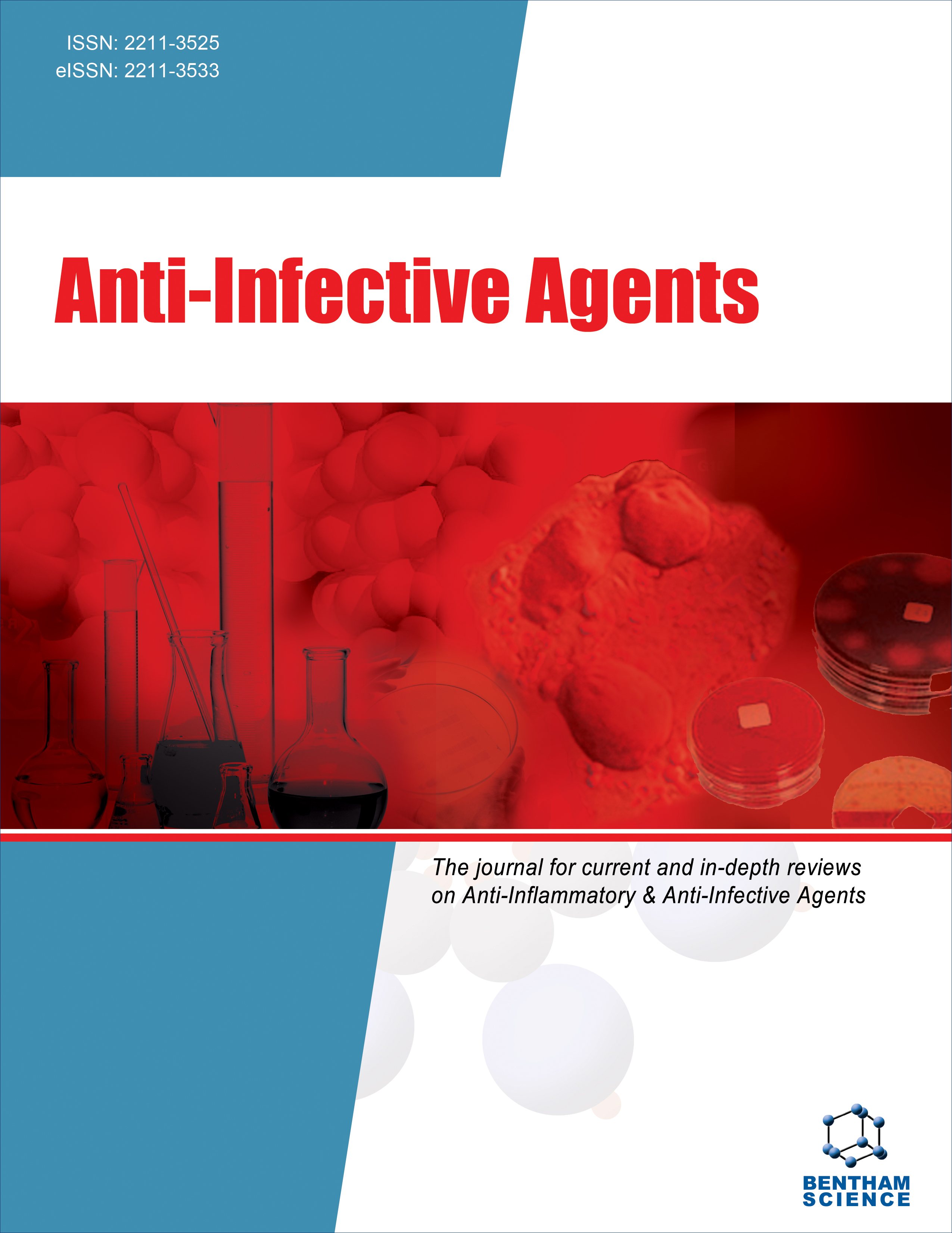- Home
- A-Z Publications
- Anti-Infective Agents
- Previous Issues
- Volume 17, Issue 2, 2019
Anti-Infective Agents - Volume 17, Issue 2, 2019
Volume 17, Issue 2, 2019
-
-
Pharmacological Exploitation of Non-Steroidal Anti-inflammatory Drugs as Potential Sources of Novel Antibacterial Agents
More LessAuthors: Ebrahim M. Yimer, Ousman A. Mohammed and Seid I. MohammedseidThe ever-increasing threat of bacterial infections and antimicrobial resistance calls for a global effort to deal with this problem. This fast and universal dissemination of antimicrobialresistant bacterial strains resulted in the diminution of therapeutic alternatives for various infectious diseases. Besides, the unaffordability of efficacious antimicrobials coupled with the occurrence of unpleasant adverse effects calls for th Read More
-
-
-
Structure-Activity Relationship of Dicoumarol Derivatives as anti-Staphylococcus aureus (Staph Infection) Agents
More LessAuthors: Nidaa Rasheed, Natalie J. Galant and Imre G. CsizmadiaIntroduction: Staph infection, caused by a bacterium known as Staphylococcus aureus, results in a range of diseases from cellulitis to meningitis. Dicoumarol compounds are now emerging as new anti-Staph infection agents as they possess a different chemical structure than compounds used in previous treatments, in order to combat antibiotic-resistant strains. However, it is unclear how such chemical modulations to the dico Read More
-
-
-
Deboronation of New Clarithromycin-Benzo[c][1,2]oxaborole Conjugates
More LessBackground: The conjugates of antibiotics are new molecules that might show new antibacterial spectrum and overcome resistance of insusceptible bacterial strains. Modification of known antibiotics like Clarithromycin with active fragments is laborious and proven method to overcome resistance of such strains. Methods: The conjugates of Clarithromycin and Benzo[c][1,2]oxaboroles were synthesized using lo Read More
-
-
-
Synthesis and Evaluation of 3-(1,3-dioxoisoindolin-2-yl)-N-substituted Phenyl Benzamide Analogues as HIV Integrase Strand Transfer Inhibitors
More LessAuthors: Pankaj Wadhwa, Priti Jain, Arpit Patel, Shantanu Shinde and Hemant R. JadhavBackground: A series of novel 3-(1,3-dioxoisoindolin-2-yl)-N-substituted phenyl benzamide derivatives was synthesized and tested in vitro against human immunodeficiency virus type-1 Integrase (HIV-1 IN). Methods: Out of the 18 analogues, six (compounds 16c, 16h, 16i, 16m, 16n and 16r) showed significant inhibition of strand transfer by HIV-1 integrase. For these six compounds. IC50 was below 5.0 μM. In silico docking stu Read More
-
-
-
Synthesis of Some 5-(substituted benzylidene-2, 4-dioxothiazolidin-3-yl) benzoic Acid Derivatives by Conventional and Microwave-assisted Methods and Evaluation of their Potential as Antimicrobial Agents
More LessAuthors: Karuna S. Shukla, Shailendra Pandey and Pooja ChawlaBackground: Multiple antibiotic resistant bacteria represent a challenge in the treatment of infections. It is imperative, therefore, that new substances with antimicrobial properties should be searched to fight these microorganisms. Objective: A series of 5-benzylidene-2, 4-dioxothiazolidin-3-yl benzoic acid derivatives were synthesized and evaluated their antimicrobial potential. The compounds were synthes Read More
-
-
-
Prophylactic and Therapeutic Treatments' Effect of Moringa Oleifera Methanol Extract on Cryptosporidium Infection in Immunosuppressed Mice
More LessAuthors: Nagwa M. El-Sayed and Ghada M. FathyBackground: As natural herbs and medicinal plants extracts are widely used as alternative treatments for different parasitic diseases, some have been tested on Cryptosporidium either in vitro or in vivo. This study assessed the prophylactic and therapeutic treatments' effect of Moringa oleifera (M. oleifera) leaves methanol extract on immunosuppressed-Cryptosporidium infected mice. Methods: The evaluation was carri Read More
-
-
-
New Trypanosoma cruzi Trypanothione Reductase Inhibitors Identification using the Virtual Screening in Database of Nucleus Bioassay, Biosynthesis and Ecophysiology (NuBBE)
More LessBackground: American trypanosomiasis, also known as Chagas disease, is caused by the protozoan Trypanosoma cruzi (T. cruzi) and affects approximately 10 to 12 million, primarily in Latin America. Since its discovery in 1909, there is no effective treatment for its chronic phase, with benzonidazole being the only anti-trypanosoma drug used in Brazil, despite the absence of conclusive evidence to prove its efficacy and Read More
-
-
-
Sonic Stimulation and Low Power Microwave Radiation Can Modulate Bacterial Virulence Towards Caenorhabditis elegans
More LessAuthors: Priya Patel, Hiteshi Patel, Dhara Vekariya, Chinmayi Joshi, Pooja Patel, Steven Muskal and Vijay KothariBackground: In view of the global threat of antimicrobial resistance, novel alternative approaches to deal with infectious bacteria are warranted, in addition to the conventional invasive therapeutic approaches. Objective: This study aimed at investigating whether exposure to sonic stimulation or microwave radiation can affect virulence of pathogenic bacteria toward the model nematode host Caenorhabditis elegans. Methods: Ca Read More
-
Most Read This Month
Article
content/journals/aia
Journal
10
5
false
en


